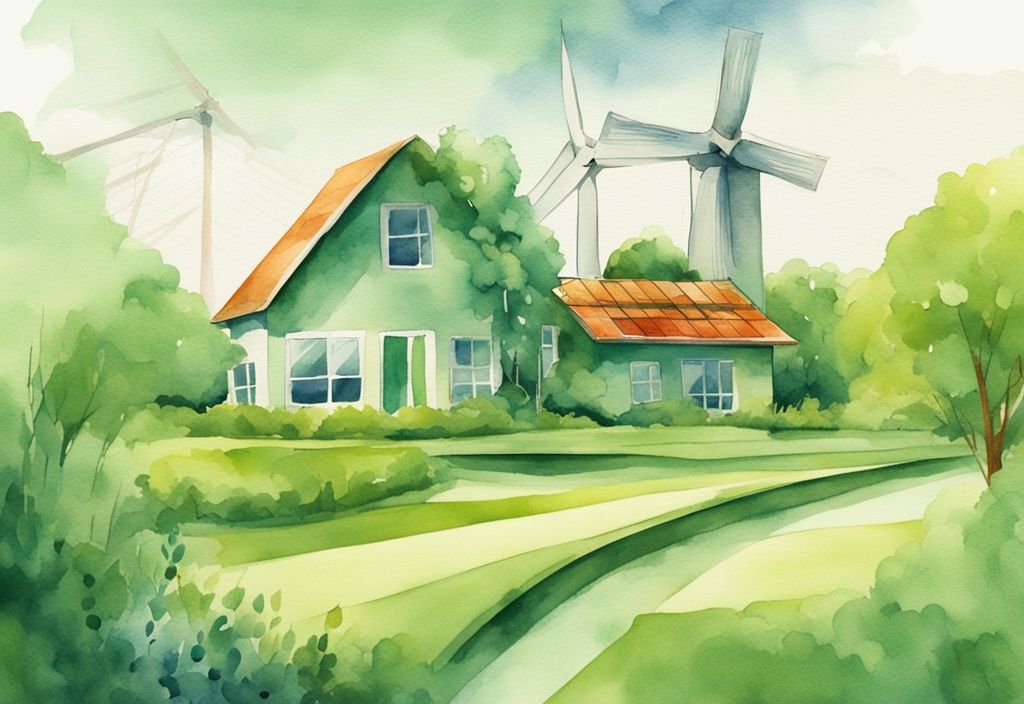Understanding What Does Eco Friendly Mean: A Beginner’s Guide
Ever wondered, “What does eco friendly mean?” Well, consider this your green initiation. Eco-friendliness isn’t just a buzzword; it’s a lifestyle choice that influences our everyday decisions intending to respect and nurture our planet. From adopting practices that conserve resources, choosing products that minimize pollution, to making decisions that uphold environmental health, being eco-friendly is about paving the way for a sustainable future.
Delve into this guide to understand the origin, characteristics, and practical applications of eco-friendliness. Get a glimpse of how your life can transform when green gets the limelight. Remember, when you embrace sustainable habits, it’s not just the planet that thrives; you reap healthful benefits too!
So let’s embark on an enlightening journey together, discovering how each eco-action echoes a healthier lifestyle and a happier planet. Dive in and join me on this green adventure!
Exploring the Definition of Eco-Friendly
Eco-friendly essentially means “not environmentally harmful.” It embodies the principle of engaging in activities, choices, and practices that have a positive or neutral impact on the environment. This includes anything that assists in the conservation of resources, reduces pollution, and fosters sustainable growth.
In essence, eco-friendly implies conducting life in a manner that prioritizes environmental health and reduces the ecological footprint. Often, the term is synonymous with phrases like environmentally friendly, green, and sustainable as they all highlight the significance of minimizing environmental impact and fostering long-term ecological balance.
The Origin and Importance of the Term
The term “eco-friendly” entered popular usage in 1989. Derived from the Latin root ‘oeco,’ which means ‘household,’ the term extends to denote ‘habitat,’ ‘home,’ or even ‘Earth.’
This origin emphasizes the idea of taking care of our surroundings as one would take care of their home, highlighting the interconnection with our natural habitat.
The significance of the term “eco-friendly” is profound as it nudges individuals and organizations toward adopting practices that reduce the adverse impact on the environment. By encouraging sustainable actions and conservation efforts, it plays a crucial role in safeguarding ecological integrity for future generations.
A Look into Eco-Friendly Products
Eco-friendly products embody sustainability, designed not only to reduce harm to our planet but also to ensure that future generations thrive. Let’s delve into their key characteristics and lifecycle to better understand their profound impact.
Recognizing Key Characteristics
Eco-friendly products are a testament to thoughtful design and sustainability. They don’t drain our natural resources or hamper future needs. For instance, I once switched to an eco-friendly dishwasher that used significantly less water and energy—talk about reducing that environmental footprint. These products usually call for fewer resources during manufacturing, leading to lower greenhouse gas emissions and playing a part in combating climate change.
One might wonder about the safety of these products. I remember feeling a lot safer knowing that my eco-friendly cleaning supplies were free from toxic chemicals, which made them better for us and the Earth. This conscious approach also means that eco-friendly products aim to have a gentle impact on our land, air, and water, culminating in a healthier planet for everyone.
Product Lifecycle: From Manufacturer to Disposal
Now, if you’re asking, “what does eco friendly mean,” understanding the lifecycle of these products is vital. From start to finish, these products are sculpted to minimize their environmental toll. During manufacturing, waste is cut down, and carbon footprints are slashed. Picture the joy of knowing that even the production methods of your favorite eco-friendly gadget rely on sustainable materials and efficient processes.
But the journey doesn’t end there. Post-use, such products often support composting and recycling, ensuring they reintegrate into nature harm-free. This reminds me of my first eco-friendly toothbrush, which was compostable—every bit of it returned to the Earth without harm.
It’s essential to remember that perfection isn’t the goal here. Rather, eco-friendly products stand out because they considerably reduce specific environmental impacts even if they aren’t flawless. If you’re wondering about other eco-friendly products, you might ask, does Native shampoo help with dandruff and find more sustainable options. By zeroing in on reducing production waste, cutting down carbon emissions, and ensuring graceful end-of-life disposal, these products offer a genuinely sustainable choice.
Incorporating these products into our lives may seem a bit intimidating at first but embracing eco-friendly options can lead to rewarding and impactful changes. Small steps in the right direction, like choosing products that align with eco-friendly principles, can collectively bring about significant positive changes for our health and the environment.

Examples of Eco-Friendly Products and Practices
Towards a Greener Lifestyle: Eco-Friendly Choices for Everyday
Eco-friendly choices are crucial for reducing our environmental footprint and promoting sustainability. Understanding what does eco-friendly mean is the first step towards adopting sustainable habits. Let’s start with optimizing resources like water and energy. Simple measures such as fixing leaks, taking shorter showers, and using energy-efficient appliances can make a significant difference. Adopting a mindful approach to consumption helps in conserving these valuable resources.
Decreasing waste production is another impactful practice. Remember to always reduce, reuse, and recycle. Opt for reusable shopping bags, storage containers, and utensils instead of single-use plastics. Composting organic waste not only lowers the volume of garbage sent to landfills but also enriches the soil naturally.
Choosing products with less or recyclable packaging is an essential part of an eco-friendly lifestyle. Brands that use sustainable packaging materials help reduce waste and lessen their environmental impact. Stay vigilant about the type of packaging materials used and prioritize items with minimal and recyclable packaging.
Adopting a plant-based diet can considerably lower your carbon footprint. Plant-based foods typically require fewer resources such as water and land for production and contribute less to greenhouse gas emissions. Even gradually incorporating more plant-based meals into your diet can have a substantial environmental benefit.
Switching to biodegradable cleaning products reduces the amount of toxic chemicals released into the environment. Similarly, using energy-efficient light bulbs, like LEDs, not only conserves electricity but also reduces the frequency of replacements, further minimizing waste.
Eco-Friendly vs. Sustainable: Unveiling the Differences
While understanding what does eco-friendly mean is important, distinguishing it from sustainability provides a more comprehensive perspective on environmental responsibility. Eco-friendly actions and products aim to minimize environmental harm. Activities like recycling, using renewable energy sources, and choosing biodegradable products are typically referred to as eco-friendly.
Sustainability, however, encompasses a broader spectrum, including social and economic dimensions alongside environmental concerns. According to the United Nations Brundtland Commission, sustainability is defined as “meeting the needs of the present without compromising the ability of future generations to meet their own needs.” This definition underscores the importance of balancing ecological, social, and economic factors.
The difference between “environmentally friendly” and “eco-friendly” also plays a significant role here. Environmentally friendly implies actions or products that cause minimal harm to the environment but may not necessarily take the entire lifecycle into consideration. In contrast, eco-friendly often implies a more holistic approach, ensuring that the products or practices are beneficial across different stages—from production to disposal.
Achieving true sustainability requires a commitment to continuous improvement and integrating eco-friendly practices into broader social and economic policies. This can involve supporting renewable energy projects, advocating for fair trade practices, and contributing to community resilience and well-being. Therefore, while eco-friendly practices are a crucial part of the sustainability journey, the latter demands a more system-wide and long-term approach to create lasting positive impacts on the planet.
Implications of Being Eco-Friendly
Understanding what does eco friendly mean is crucial to grasping its broader implications for environmental and social compliance. It’s not just about surface-level initiatives; one must examine the entire environmental and social compliance footprints of factories and businesses. Eco-friendly practices are designed to reduce, and ideally eliminate, negative environmental impacts. By focusing on sustainable processes, industries can minimize pollution and promote better working conditions and fair trade practices. These eco-friendly products are key contributors to overall sustainability by mitigating immediate environmental damage, fostering a healthier planet.
The Role and Impact on Environmental and Social Compliance
When we delve into what eco friendly means, it becomes evident that true sustainability involves more than just reducing waste or conserving water. It requires a committed approach to reviewing and improving the entire life cycle of products, from raw material sourcing to final disposal. Every step must be scrutinized for its impact on both the environment and people. Sustainable practices in industries can lead to a significant reduction in greenhouse gas emissions, less resource depletion, and improved ecosystems.
Government Regulations and Business Practices
Government regulations and conscientious business practices are pivotal in facilitating eco-friendly living. Consider that governments implement policies and regulations to encourage eco-friendly initiatives and sustainable business operations. The Federal Trade Commission (FTC) in the United States has stringent guidelines on eco-friendly claims. To understand what does eco friendly mean, know that packaging must provide clear explanations about why a product is environmentally responsible.
Moreover, eco-friendly certifications such as the Green Seal in the USA and the EU Ecolabel in Europe serve as trustworthy indicators. These certifications ensure that products meet rigorous environmental standards, making it easier for consumers to make informed, sustainable choices. By adhering to these standards, businesses can significantly contribute to environmental preservation and social responsibility, exemplifying the true essence of eco-friendliness.
Decoding Green Certifications and Labels
When faced with a plethora of green certifications and labels on products, understanding what does eco-friendly mean becomes essential. True eco-friendly products showcase transparency in their commitments. These manufacturers openly share the ingredients used, their sustainable practices, and their environmental contributions. This transparency ensures that you are fully informed about the eco-friendly initiatives behind the product.
To verify the authenticity of a product’s eco-friendliness, you should look for third-party verified logos. Certifications like EcoCert Cosmos and Fair Trade Certified are respected markers of genuine eco-friendly products. These certifications are awarded after a rigorous evaluation of the product’s lifecycle, from sourcing and production to disposal, ensuring the product meets strict environmental and social standards.
It is vital to scrutinize eco-friendly labels diligently. Ensure these labels are not merely marketing gimmicks but genuinely contribute to broader sustainability goals. Authentic eco-friendly products will detail their positive impacts on the environment and promote sustainability throughout their entire lifecycle. This careful evaluation helps you avoid falling prey to greenwashing practices, where companies make unfounded claims of being environmentally friendly without substantial proof.

By understanding and recognizing genuine eco-friendly certifications and labels, you can make informed choices that support sustainable practices and contribute to a healthier planet. Have you ever stood in a grocery aisle, overwhelmed by the sea of eco-friendly labels, unsure which cleaning product is truly the green choice? In today’s world, consumers are bombarded with messages about sustainability, but with so much ‘greenwashing,’ it’s hard to separate genuine efforts from the noise. For more insight on this topic, check out the importance of product certifications for environmental sustainability here.
Evading Greenwashing: Stay Informed, Choose Wisely
Understanding what does eco friendly mean is crucial in identifying greenwashing, a deceptive practice where companies make unsubstantial claims about their environmental benefits. Greenwashing can mislead consumers into thinking they are making eco-friendly choices when they are not.
Recognizing Greenwashing Tactics
Greenwashing involves the use of misleading marketing to make products appear more environmentally friendly than they truly are. Companies might use vague terms like “green” or “natural” without providing concrete evidence or certifications that back up these claims. Ensuring you have a clear understanding of what does eco friendly mean is the first step in avoiding these pitfalls.
Common Examples of Greenwashing
- Free of Phosphates: Labeling a product as “free of phosphates” might seem eco-friendly, but it can be misleading if phosphates have already been phased out industry-wide. This tactic can give a false impression of enhanced environmental benefits.
- All Natural: Terms like “all natural” can be misleading if the product, despite using natural ingredients, involves synthetic manufacturing processes. Understanding what does eco friendly mean helps differentiate between truly sustainable products and those merely posing as such.
- Biodegradable or Recyclable Labels: Some products claim to be “biodegradable” or “recyclable,” but if they do not break down quickly or are not recyclable through common municipal methods, these claims can be deceptive.
How to Make Smarter, Informed Decisions
Making well-informed decisions about products can significantly aid in minimizing environmental damage. Firstly, always look for transparency in claims. Genuine eco-friendly products explicitly state which ingredients they use and provide information on their sustainability practices.
Secondly, seek third-party verified certifications such as EcoCert Cosmos or the Fair Trade Certified label. These certifications ensure that the products meet stringent environmental standards.
Additionally, keep in mind the lifecycle impacts of the products you choose. Consider the energy and resources required for production, their sustainability throughout their usage, and the disposal process.
By staying informed about what does eco friendly mean and understanding the nuances of greenwashing, consumers can make choices that genuinely benefit the environment and promote broader sustainability goals.
What’s Next for Eco-Friendliness?
The future of eco-friendliness revolves around integrating emerging technologies and heightened environmental awareness. The ongoing shift prioritizes ecological, social, and economic sustainability, fostering long-term positive change. Here’s a look at the key areas where innovations are shaping what does eco-friendly mean:
Tech Innovations and Growing Environmental Awareness
As we deepen our understanding of what eco-friendly means, the fusion of technological advancements and sustainable practices is set to transform our world. Balancing ecological, social, and economic factors, this integration promises lasting impact and a more sustainable future.
One exciting development is the rise in renewable energy technologies. Innovations in solar power, wind turbines, and advanced battery storage are making these solutions more efficient and accessible. These technologies are pivotal in reducing our dependence on fossil fuels, curbing carbon footprints, and combating climate change. Moreover, energy-efficient appliances are becoming more common, underscoring the principle of conserving resources, a core aspect of what does eco-friendly mean.
Sustainable agriculture is another field witnessing significant progress. Techniques like precision farming, vertical gardens, and biodegradable materials for crop protection are revolutionizing food production. These practices help reduce the environmental impact by minimizing chemical inputs and conserving water, which aligns perfectly with the eco-friendly ethos.
Urban planning and architecture are also embracing eco-friendliness with green building technologies. Features like green roofs, energy-efficient insulation, and smart home systems promote sustainable living. These innovations not only reduce energy consumption but also decrease waste and enhance indoor air quality, embodying key elements of what does eco-friendly mean.

Waste management technologies are equally crucial to our sustainable future. Advanced recycling methods, biodegradable packaging, and waste-to-energy systems significantly cut down on landfill usage and promote material reuse. These efforts resonate with the eco-friendly mandate to lower environmental impact.
Growing environmental awareness is driving consumer demand for eco-friendly products and practices. This pressure encourages companies to innovate and adopt sustainable methods. Certifications and labeling are essential tools in this landscape, helping informed consumers verify authentic eco-friendly claims and combat greenwashing.
In conclusion, the future of eco-friendliness lies in the interplay of technology, awareness, and responsible practices. Continuous innovation and a collective commitment to sustainability bring us closer to securing a thriving, balanced planet for future generations. Truly grasping what does eco-friendly mean and applying these principles widely are vital steps toward achieving this vision.
Frequently Asked Questions about Eco-Friendliness
Deciphering Sustainability and Eco-Friendliness in Products
Sustainability, as defined by the United Nations Brundtland Commission, means “meeting the needs of the present without compromising the ability of future generations to meet their own needs.” This broad concept covers ecological, social, and economic factors.
But what does eco-friendly mean? Eco-friendly products and practices aim to minimize harm to the environment. While sustainability and eco-friendliness are often used interchangeably, eco-friendliness focuses primarily on reducing environmental impact.
To determine if a product is eco-friendly, compare its environmental footprint to that of similar products. Think about factors like resource use, emissions, and lifecycle impact. This way, you can better evaluate its sustainability.
How Can You Include Eco-Friendliness in Your Everyday Choices?
Incorporating eco-friendliness into daily life is straightforward. Start with small steps like reducing waste, recycling, and reusing items. Conserve water by fixing leaks and using water-efficient fixtures.
Reduce energy consumption by choosing energy-efficient appliances. Look for products certified by reputable eco-friendly organizations, like Green Seal or EU Ecolabel, which ensure minimal environmental impact.
Support businesses that practice sustainability, such as Certified B-Corps. Additionally, offset your carbon footprint by planting trees or supporting renewable energy initiatives.
Remember, small, consistent efforts can lead to significant positive environmental impacts.
Wrap Up
Understanding Eco-Friendliness
Understanding eco-friendliness has been a key turning point in my journey towards reducing environmental impacts and embracing sustainable living. Knowing what does eco friendly mean has enabled me to make decisions that not only benefit my health but also the planet. Essentially, eco-friendly actions, products, and practices are aimed at conserving resources, reducing pollution, and maintaining the balance of natural ecosystems.
Importance of Making Informed Choices
It’s amazing how making informed choices can conserve resources and reduce pollution. Once you understand what does eco friendly mean, it becomes easier to opt for products and practices that align with broader sustainability goals. Simple actions like reducing energy and water consumption, using minimally packaged products, and choosing renewable energy sources together make a huge difference.
This approach not only supports environmental conservation but also ensures future generations have the resources they need. Personally, I’ve found making these small adjustments in my daily life incredibly rewarding, and I believe you will too.
Continuous Learning and Adaptation
I’ve learned that continuous learning and adaptation to eco-friendly practices are essential for fostering a healthier planet. As technologies and our understanding of environmental science evolve, our habits and choices should evolve too. Staying updated on new eco-friendly innovations and incorporating them into daily life can lead to long-lasting positive effects on the environment.
Embracing habits such as composting, recycling, and patronizing companies committed to sustainability has transformed my lifestyle. It’s reassuring to know these efforts contribute to a collective movement towards a more sustainable future. From personal experience, the journey to living eco-friendly is both attainable and incredibly rewarding.
Hi, I’m Olivia Green, the voice behind nontoxicways.com. I’m passionate about helping you make the shift to a healthier, non-toxic lifestyle without feeling overwhelmed. I love sharing my personal journey, from small changes to big transformations, along with practical tips that make it all feel doable. My goal is to inspire and guide you toward a lifestyle that benefits both your well-being and the planet. Let’s take this journey together, one simple step at a time!














Post Comment